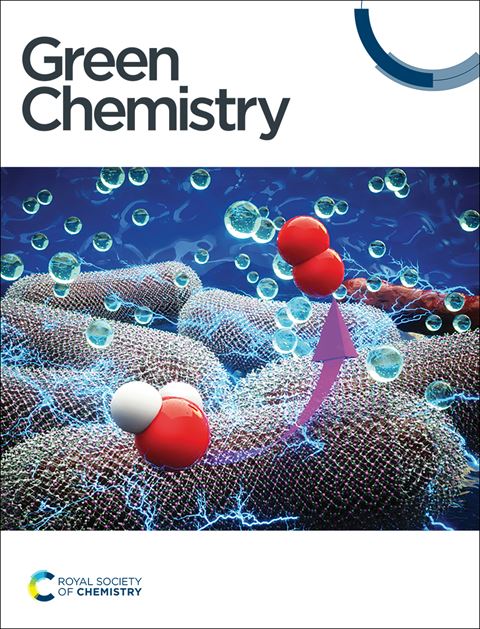用卡夫木质素代替聚丙烯腈,实现可持续的碳纤维制造,减少碳排放†
IF 9.3
1区 化学
Q1 CHEMISTRY, MULTIDISCIPLINARY
引用次数: 0
摘要
虽然碳纤维作为各种先进材料的基础而备受追捧,但其制造过程是能源密集型的,碳排放量高。用绿色生物聚合物取代碳纤维的石油衍生聚丙烯腈(PAN)前体可能会提高碳纤维行业的可持续性,但这种替代品如何减少碳排放仍然是一个难以捉摸的问题。在这项研究中,我们进行了一个生命周期评估(LCA),从生物精炼废料中提取植物来源的木质素生物聚合物,以替代PAN在碳纤维生产中的应用。用工业软木硫酸盐木质素代替50%的PAN,采用湿法纺丝制备木质素/PAN前体纤维,然后进行热稳定和碳化。LCA研究表明,由PAN制成的碳纤维每公斤碳纤维的碳排放量为23.3 kg CO2-eq,而用木质素替代50%的PAN每公斤碳纤维的碳排放量为19.5 kg CO2-eq,碳排放量减少了16.3%。对加工过程碳排放的主要贡献分析表明,纺丝制备的碳排放量最高,其次是热稳定、湿纺丝和碳化。在不同的生产要素中,消耗的电力产生的碳排放量最高,其次是前驱体聚丙烯腈。在其他环境影响中,电力是最大的贡献者,而纺丝dopes的制备对环境的影响最大。进一步的敏感性分析表明,增加纺丝束和碳产量可以降低碳排放和其他环境影响。所有这些结果都表明,使用木质素代替PAN可以显著减少碳排放,实现更环保的碳纤维生产。本文章由计算机程序翻译,如有差异,请以英文原文为准。

Replacing polyacrylonitrile with Kraft lignin for sustainable carbon fiber manufacturing mitigates carbon emissions†
Although carbon fibers have been significantly sought after as the foundation of various advanced materials, their manufacturing is energy-intensive with high carbon emissions. Replacing the petroleum-derived polyacrylonitrile (PAN) precursor of carbon fibers with green biopolymers can potentially enhance the sustainability of the carbon fiber industry, but how this replacement can mitigate carbon emissions is still elusive. In this study, we performed a life cycle assessment (LCA) on the alternative of a plant-derived lignin biopolymer from biorefining waste for the replacement of PAN in carbon fiber production. Here, 50% of PAN was replaced with an industrial softwood Kraft lignin, and wet spinning was used for making lignin/PAN precursor fibers, followed by thermostabilization and carbonization. LCA study revealed that carbon fibers made from PAN could induce carbon emissions of 23.3 kg CO2-eq per kg carbon fibers, while 50% replacement of PAN with lignin led to carbon emissions of 19.5 kg CO2-eq per kg carbon fibers, representing a 16.3% reduction in carbon emissions. Analysis of the main contributions to carbon emissions from processing demonstrated that the preparation of spinning dopes had the highest carbon emission, followed by thermostabilization, wet spinning, and carbonization. Among the different production factors, consumed electricity generated the highest carbon emissions, followed by the precursor PAN. Among other environmental impacts, electricity represented the highest contributor, and the preparation of spinning dopes had the most environmental impacts. Further sensitivity analysis elucidated that increasing the spinning tow and carbon yield led to lower carbon emissions and other environmental impacts. All these results highlighted that using lignin instead of PAN could significantly mitigate carbon emissions for greener carbon fiber production.
求助全文
通过发布文献求助,成功后即可免费获取论文全文。
去求助
来源期刊

Green Chemistry
化学-化学综合
CiteScore
16.10
自引率
7.10%
发文量
677
审稿时长
1.4 months
期刊介绍:
Green Chemistry is a journal that provides a unique forum for the publication of innovative research on the development of alternative green and sustainable technologies. The scope of Green Chemistry is based on the definition proposed by Anastas and Warner (Green Chemistry: Theory and Practice, P T Anastas and J C Warner, Oxford University Press, Oxford, 1998), which defines green chemistry as the utilisation of a set of principles that reduces or eliminates the use or generation of hazardous substances in the design, manufacture and application of chemical products. Green Chemistry aims to reduce the environmental impact of the chemical enterprise by developing a technology base that is inherently non-toxic to living things and the environment. The journal welcomes submissions on all aspects of research relating to this endeavor and publishes original and significant cutting-edge research that is likely to be of wide general appeal. For a work to be published, it must present a significant advance in green chemistry, including a comparison with existing methods and a demonstration of advantages over those methods.
 求助内容:
求助内容: 应助结果提醒方式:
应助结果提醒方式:


